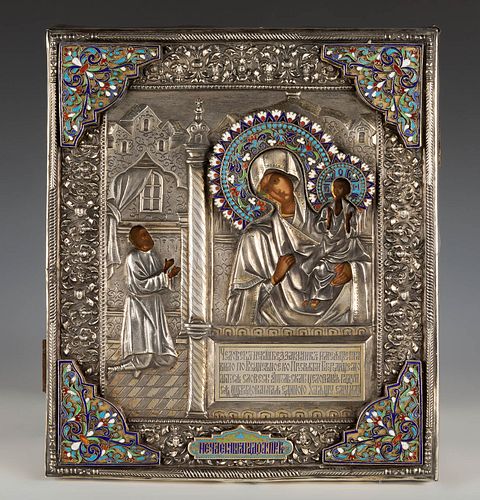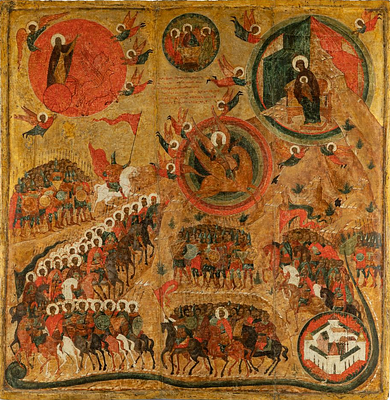Russian school, late 19th century. Master silversmith Andrei Alexandrov. "Ecstasy of Repentance". Tempera and gold leaf on panel. Oklad of embossed, n
Lot 62
About Seller
Setdart Auction House
Carrer Aragó 346
Barcelona
Spain
Setdart Subastas was born in 2004 and is currently the first online art auction in Spain with solidity, prestige and reliability guaranteed by our more than 60,000 users. Setdart has a young, dynamic and enterprising team ready to successfully manage the purchase and sale of art works through custom...Read more
Estimate:
EUR€6,000 - EUR€7,000
$6,250 - $7,291.67
Absentee vs Live bid
Two ways to bid:
- Leave a max absentee bid and the platform will bid on your behalf up to your maximum bid during the live auction.
- Bid live during the auction and your bids will be submitted real-time to the auctioneer.
Bid Increments
| Price | Bid Increment |
|---|---|
| EUR€0 | EUR€10 |
| EUR€200 | EUR€25 |
| EUR€500 | EUR€50 |
| EUR€1,000 | EUR€100 |
| EUR€3,000 | EUR€200 |
| EUR€5,000 | EUR€500 |
| EUR€10,000 | EUR€1,000 |
| EUR€20,000 | EUR€2,000 |
| EUR€50,000 | EUR€5,000 |
About Auction
By Setdart Auction House
Sep 23, 2021
Set Reminder
2021-09-23 10:00:00
2021-09-23 10:00:00
America/New_York
Bidsquare
Bidsquare : RUSSIAN ICONS
https://www.bidsquare.com/auctions/setdart-auction-house/russian-icons-7431
Setdart Auction House sofia@setdart.com
Setdart Auction House sofia@setdart.com
- Lot Description
Russian school, late 19th century. Master silversmith Andrei Alexandrov. "Ecstasy of Repentance". Tempera and gold leaf on panel. Oklad of embossed, nielloed and enamelled silver. Silverware made in Moscow in 1892. Measurements: 31 x 26,5 cm. The icon "The Ecstasy of Repentance", or literally translated from Russian "The Virgin of Unexpected Joy", is a miraculous icon, and especially venerated in the Russian Orthodox Church. The iconography of the subject developed towards the end of the 17th century. It is based on the account of Bishop Demetrius of Rostov, written in his twelve-volume work "Martyrology" in 1683, which relates the life story of a believer who had the habit of praying to the icon of the Mother of God before committing a sin or a crime. Once during his prayer, the icon of the Virgin and Child began to move, and the stigmata of the Infant Jesus began to bleed. The frightened believer asked Our Lady what the bleeding of Jesus Christ meant, and she replied that every sinful act opens the wounds of Christ and makes her weep. Weeping, the sinner began to pray and beg for forgiveness. On receiving the rejection of the Child Jesus, the believer kissed His wounds, and immediately the vision disappeared. Demetrius of Rostov ends the story with how the sinner changed his life. Likewise, the name of the icon, which is "unexpected joy", refers to the joy of the sinner who receives forgiveness from the Virgin. The composition of the auctioned icon exactly repeats the story of Demetrius of Rostov. In the left corner, the sinner is placed praying, kneeling before the image of the Odighidria. The Infant Jesus is dressed in torn clothes with sores. Below the representation of the Virgin is the prayer to the icon. The icon is covered in oklad, the term given to the covering of Russian Orthodox icons made of silver and, in this case, enamelled, which covers the entire surface of the icon, leaving only the faces and hands of the figures visible. Oklads can be modern and cover an older icon, or both can belong to the same period. In the case of the auctioned icon, the oklad is removable, and underneath it is an icon made in tempera and gold in a very good state of preservation. The aesthetic qualities of the icon, the quality of the details and the architectural richness indicate that these are two pieces made in the same period, towards the end of the 19th century. The oklad, in turn, has a series of punches on one of its inner sides, which help to determine the author, place and date of the piece's production. It is the work of master silversmith Andrei Alexandrov, who was active in Moscow between 1873 and 1917, and was made in 1892. Among other techniques of working with silver, including enamelling, he specialised in the technique of niello, which has a black appearance due to the mixing of metals and is used mainly in the decoration of silver objects. In Russia it is common to use this technique when decorating the oklad of icons, and the icon at auction is a clear example of this. Partially lost, it can be found in architectural decoration. Another curious detail is that the icon is titled on the lower part of the oklad, using the enamel technique and in the 'viaz' typeface, a type of calligraphy popularised in Russia in the mid-16th century, and since then frequently used in icon painting to this day.
- Shipping Info
-
In-house shipping available. Please inquire at admin@setdart.com.
-
- Buyer's Premium



 EUR
EUR CAD
CAD AUD
AUD GBP
GBP MXN
MXN HKD
HKD CNY
CNY MYR
MYR SEK
SEK SGD
SGD CHF
CHF THB
THB
















